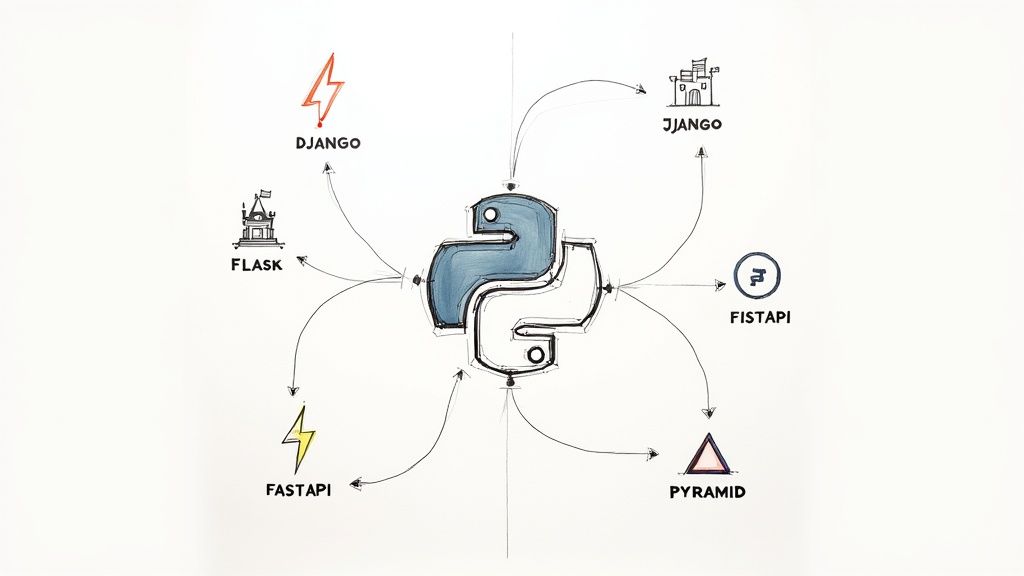
I remember my first time choosing a Python web framework. It felt like standing before a giant wall of switches, each promising a different path to a working application. Do I need a full stack solution with all batteries included like Django? Or a lightweight toolkit like Flask that lets me build from the ground up? The decision paralysis is real, especially for CTOs and founders where the wrong architectural choice can mean months of lost time.
This journey is about more than just listing the best python frameworks for web development. It's a practical guide designed to match the right tool to your specific challenge, whether you're launching an AI powered feature or building a scalable backend for a growing user base. We will dig into the tradeoffs, the 'aha' moments, and the specific problems each framework is brilliant at solving, moving from monolithic giants to speedy micro contenders.
Let us pause for a moment before we dive in. The goal here is not to crown a single winner, but to give you a map. Each framework is a different vehicle for a different terrain. We will explore what we tried, where we landed, and how you can follow along. Let's cut through the noise and find the framework that will become the backbone of your next project.
1. Django (official)
When a client needed a complex, database driven portal with a tight deadline, the "batteries included" philosophy of Django felt like a lifeline. Django isn't just a framework; it's a complete toolkit for building serious web applications. The official website is your starting point, serving as a comprehensive resource library containing documentation, release notes, and community access.
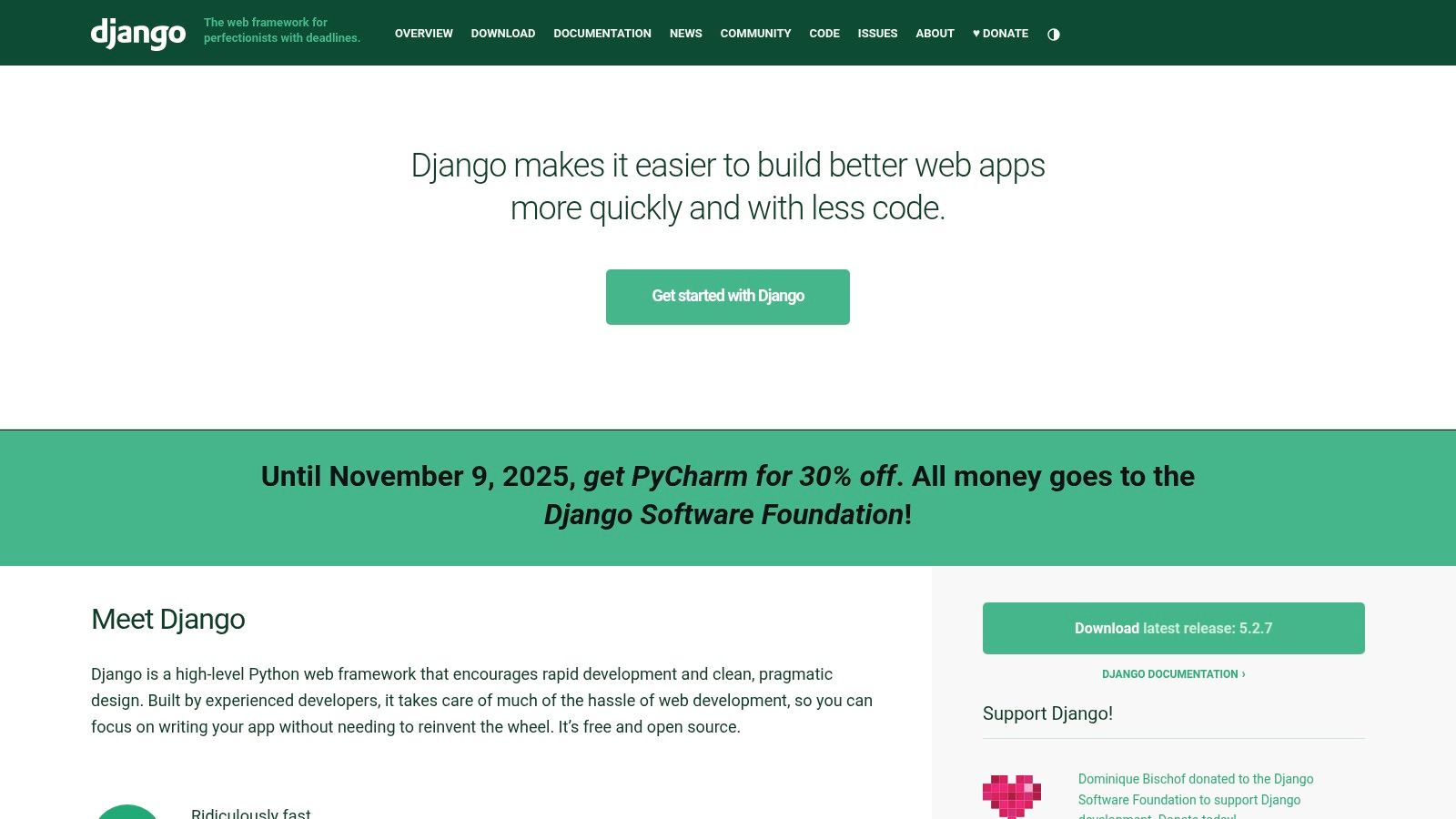
The platform's strength is its extensive and meticulously maintained documentation. For developers, this means a reliable source of truth for everything from its powerful Object Relational Mapper (ORM) to its built in admin interface. I once spent half a day trying to build a simple admin panel from scratch before realizing Django gives you one for free. Lesson learned. While Django's opinionated structure can feel rigid for microservices, it provides unparalleled speed for developing complex applications and content management systems. Its maturity ensures a stable, secure foundation with a vast ecosystem of third party packages. For building web APIs on top of this powerful framework, you can explore how to create REST APIs with the Django Rest Framework.
- Best For: Large scale, database heavy web applications, news sites, and social networks.
- Pros: Extremely mature, secure, excellent documentation, and rapid development for standard applications.
- Cons: Monolithic and opinionated structure can be overkill for small projects or APIs.
- Website: https://www.djangoproject.com/
2. Flask (official docs by Pallets)
For developers who prefer a minimalist, unopinionated starting point, the official Flask documentation by Pallets is the essential resource. It serves as the definitive guide to what many consider one of the best python frameworks for web development, especially when flexibility is paramount. Unlike monolithic frameworks, Flask provides a lightweight core, allowing you to build up your application with only the components you need. Think of it as a set of high quality Lego bricks instead of a pre assembled castle.
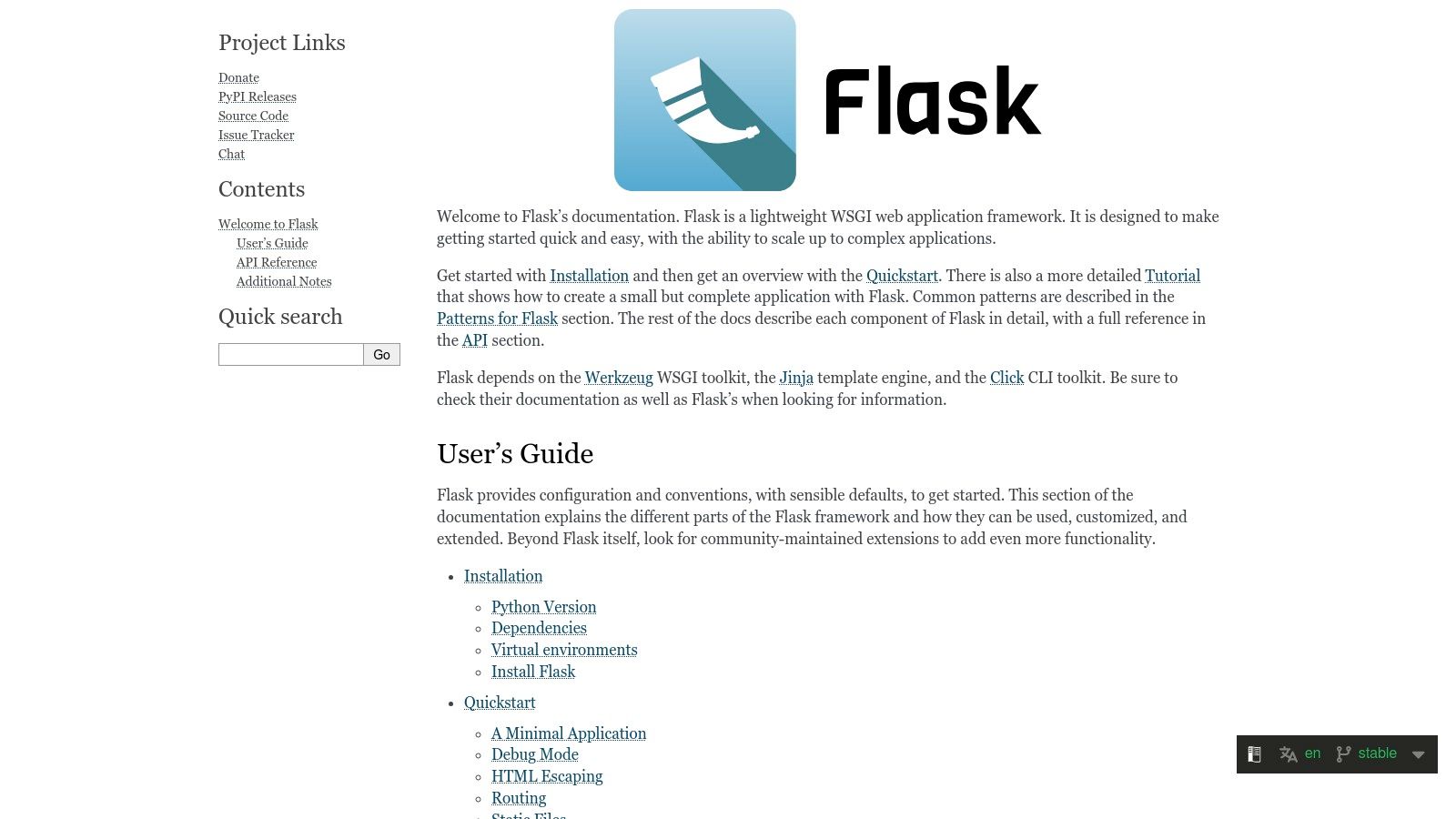
The platform's major advantage is its clear and concise documentation, which makes getting started incredibly straightforward. It expertly guides you through its minimal core, built upon Werkzeug for WSGI and Jinja for templating. While this "micro" approach means you must integrate third party libraries for an ORM or user authentication, it grants you complete control over your technology stack. This freedom is ideal for building small to medium applications, microservices, or custom solutions where a full stack framework would be overkill. It represents a different philosophy in web development, which you can explore further by getting started with web development part 1.
- Best For: Microservices, REST APIs, and small to medium sized web applications where flexibility is key.
- Pros: Highly flexible and lightweight, easy to learn, and boasts a large ecosystem of extensions.
- Cons: Requires manual integration of components for features like ORM, admin panels, and authentication.
- Website: https://flask.palletsprojects.com/
3. FastAPI (official)
We had a client whose API latency spiked one night, and the existing system just couldn't keep up. That's when we turned to FastAPI. If your primary goal is to build a blazing fast, modern API, the official FastAPI website is your essential resource. It's designed for high performance, asynchronous APIs with an exceptional developer experience.
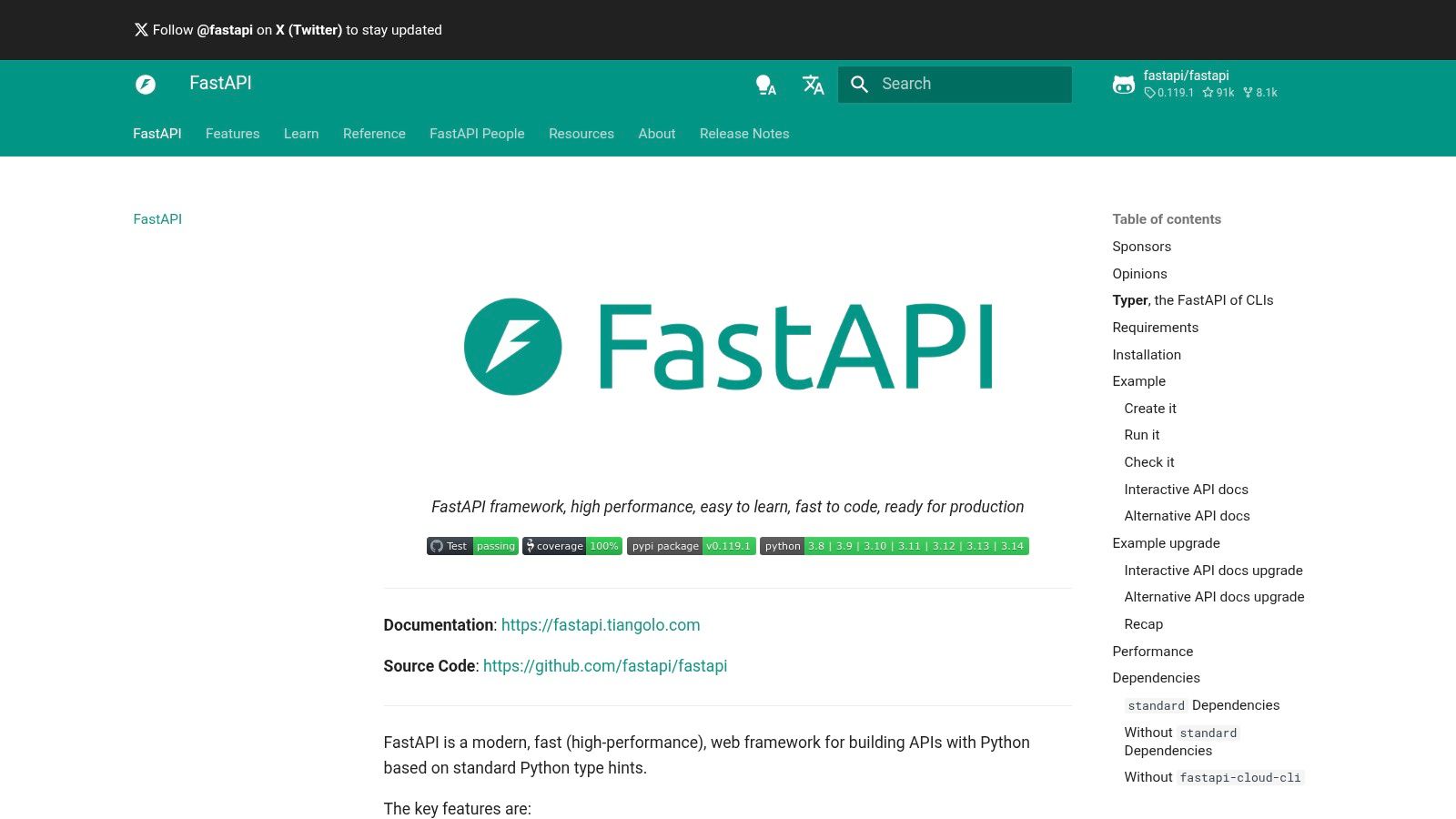
The standout feature is its tutorial first documentation. FastAPI leverages Python type hints to provide automatic data validation, serialization, and interactive API documentation generation. This focus on type safety and auto docs significantly speeds up development and catches bugs before they happen. I cannot tell you how many hours I've saved by not having to manually write OpenAPI specs. For a deeper understanding of creating great API documentation, you can explore these eight unmissable best practices. While it requires you to integrate your own ORM, its performance for API creation is nearly unparalleled.
- Best For: High performance APIs, microservices, and asynchronous web applications.
- Pros: Incredible performance, automatic interactive docs, excellent developer experience, and modern type safety.
- Cons: Focused on APIs, not a full stack "batteries included" framework; requires bringing your own components for tasks like ORM.
- Website: https://fastapi.tiangolo.com/
4. Pyramid (official)
When you find yourself stuck between the rigid opinions of a full stack framework and the bare bones nature of a microframework, the official Pyramid website offers a compelling middle ground. It introduces a "pay for what you use" philosophy, making it one of the best python frameworks for web development when you want granular control. The site serves as the main portal for this highly adaptable framework, providing comprehensive documentation for developers who value explicit component choices over convention.
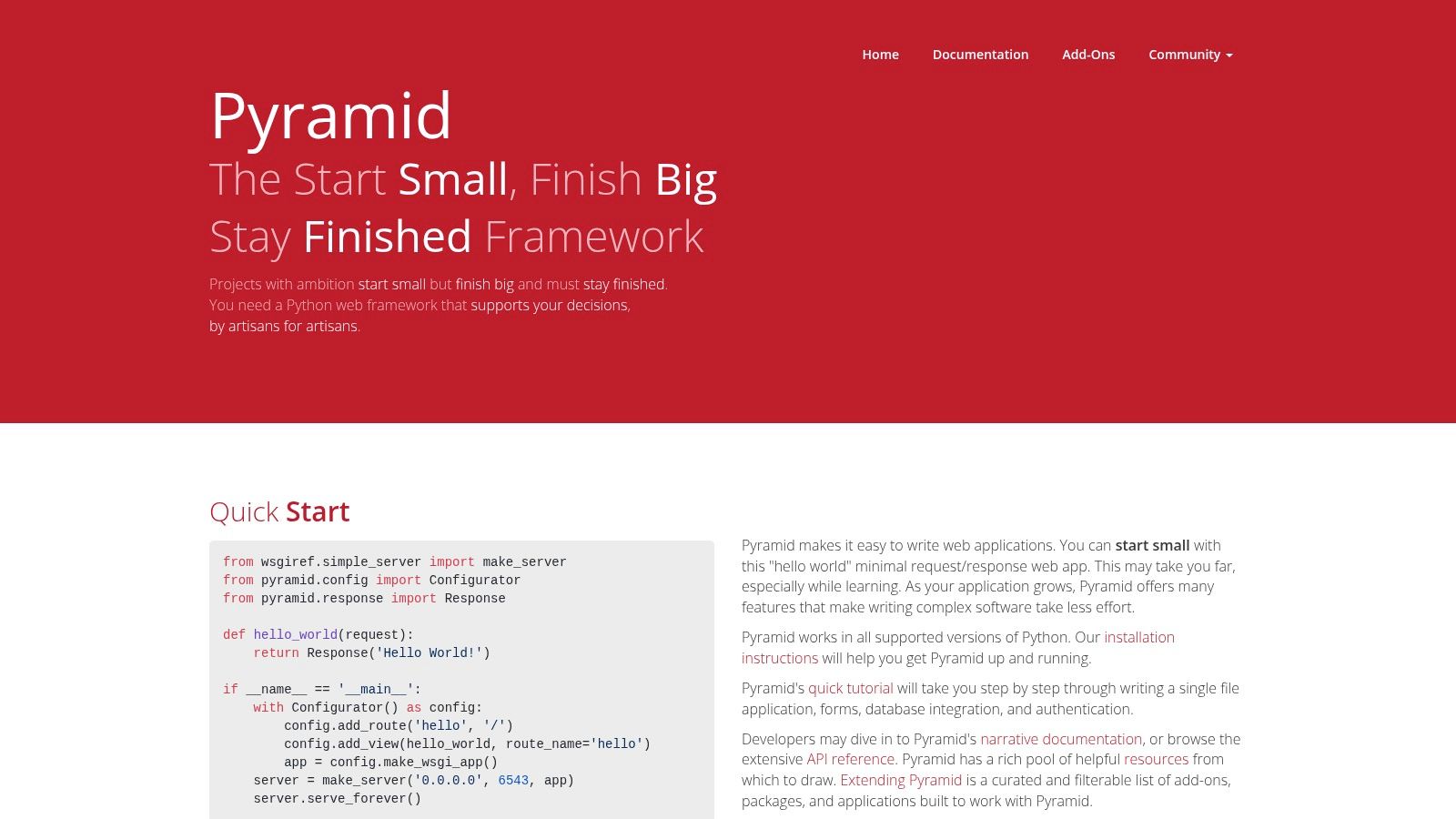
The platform's core strength lies in its unopinionated and minimalist core. This allows developers to plug in their preferred components for templating, database access, and authentication without being locked into a specific stack. While this flexibility means more initial setup decisions compared to Django, it empowers teams to build anything from a single file web app to a large scale enterprise application with a predictable structure. Pyramid's focus on explicitness helps prevent the "magic" that can sometimes obscure behavior in other frameworks, making it a solid choice for projects where long term maintainability is paramount.
- Best For: API projects, both small and large applications, and teams that want explicit control over components.
- Pros: Highly flexible and unopinionated, excellent for both small and large projects, and promotes predictable code.
- Cons: Smaller community and fewer out of the box integrations compared to giants like Django or Flask.
- Website: https://trypyramid.com/
5. Tornado (official docs)
When your application's success hinges on maintaining thousands of persistent connections for real time communication, the Tornado official documentation becomes your essential guide. This isn't just another framework; it's a powerful asynchronous networking library perfect for long polling, WebSockets, and other applications demanding a non blocking I/O model. It's a specialized tool for a specific, tough problem.
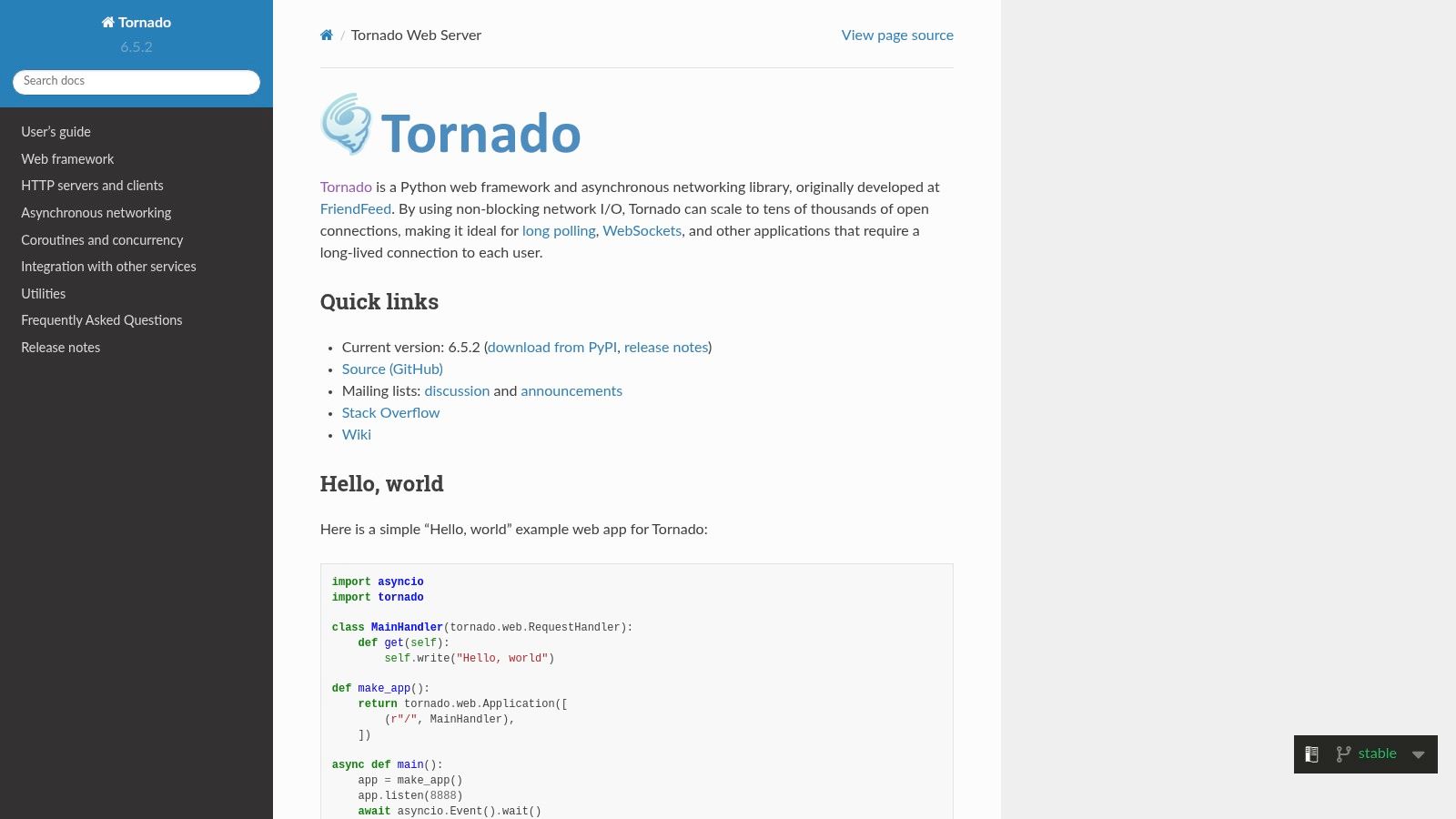
The platform's core strength is its battle tested, production grade implementation of non blocking network I/O. For developers building chat applications, real time analytics dashboards, or IoT services, this means you can handle a high number of concurrent users with minimal resource consumption. While its lower level nature requires more manual setup for things like database integration compared to full stack frameworks, it provides unparalleled performance for I/O bound tasks. Its maturity and stability make it a reliable choice for services where responsiveness and persistent connections are non negotiable.
- Best For: Real time web applications, chat services, WebSockets, and services with a high number of concurrent connections.
- Pros: Excellent for handling long lived connections, stable and well documented, and high performance for I/O bound operations.
- Cons: Requires more manual configuration than full stack frameworks and has a smaller ecosystem than Django or Flask.
- Website: https://www.tornadoweb.org/
6. Starlette (official)
When performance is paramount and you need to build asynchronous web services from the ground up, the official Starlette website is where you should turn. It is the central resource for a lightweight ASGI toolkit that underpins some of the best python frameworks for web development, including FastAPI. Think of Starlette as the high performance engine that other frameworks use to build their cars.
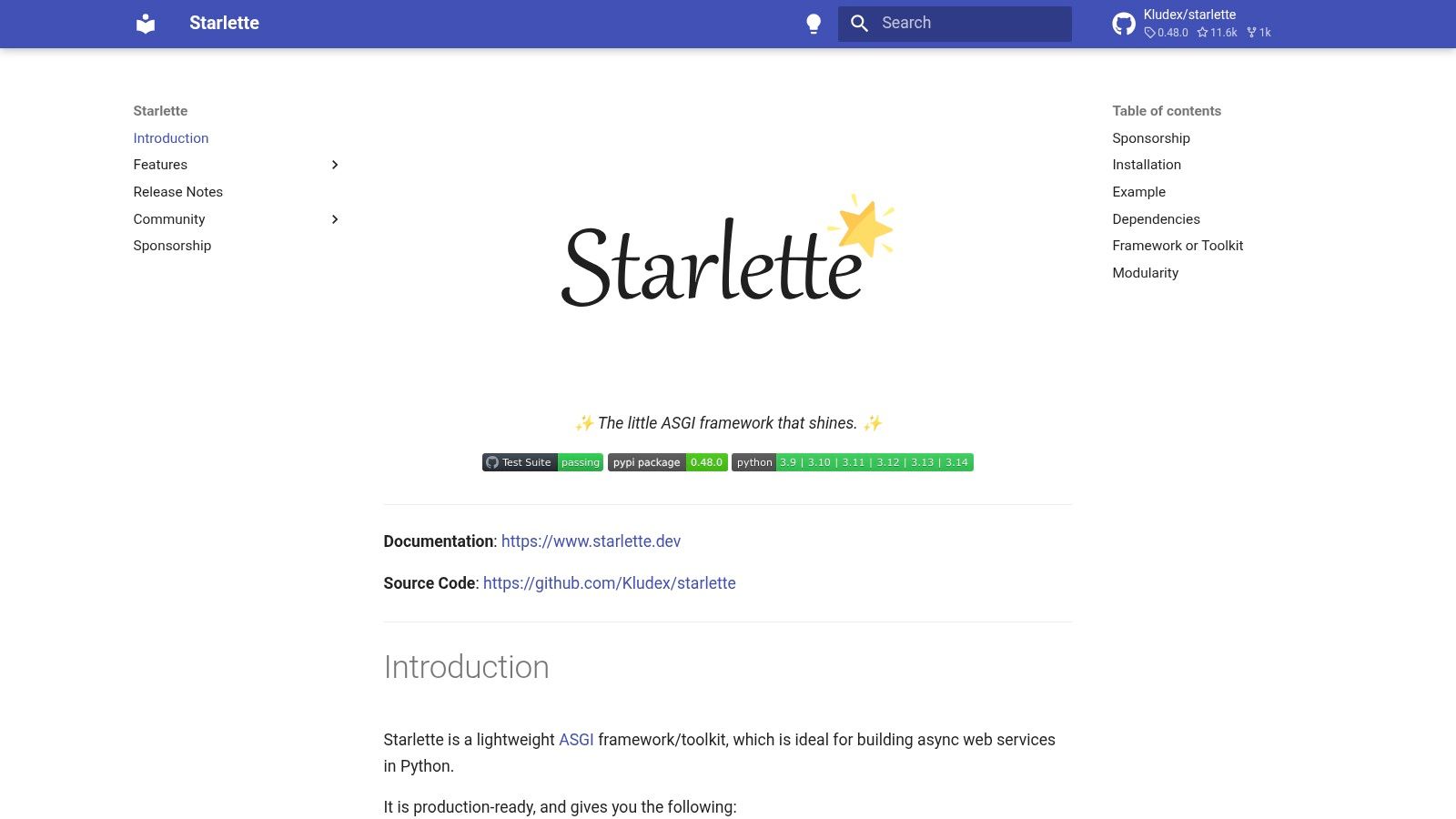
The website's primary strength is its clear, concise documentation that gets straight to the point, reflecting the framework's minimalist philosophy. It details everything from WebSocket support and background tasks to its helpful middleware. While Starlette is not a "batteries included" solution, its modularity is its greatest asset. It allows you to build high performance microservices and APIs without the overhead of components you do not need, making it an excellent choice for projects where speed and a small footprint are critical.
- Best For: High performance async APIs, microservices, and as a foundation for building other frameworks.
- Pros: Extremely fast and modular, giving you fine grained control over components. Excellent for async microservices.
- Cons: Not a full stack framework, requiring you to integrate your own ORM, admin, and templating solutions.
- Website: https://www.starlette.io/
7. Sanic (official docs)
When raw speed and asynchronous request handling are your top priorities, the official Sanic documentation is where you'll want to live. Built as an async first web framework, Sanic is designed to be fast, unopinionated, and modern. The documentation site is the essential resource for developers building high throughput services, providing a clear user guide and API references for this performance oriented framework.
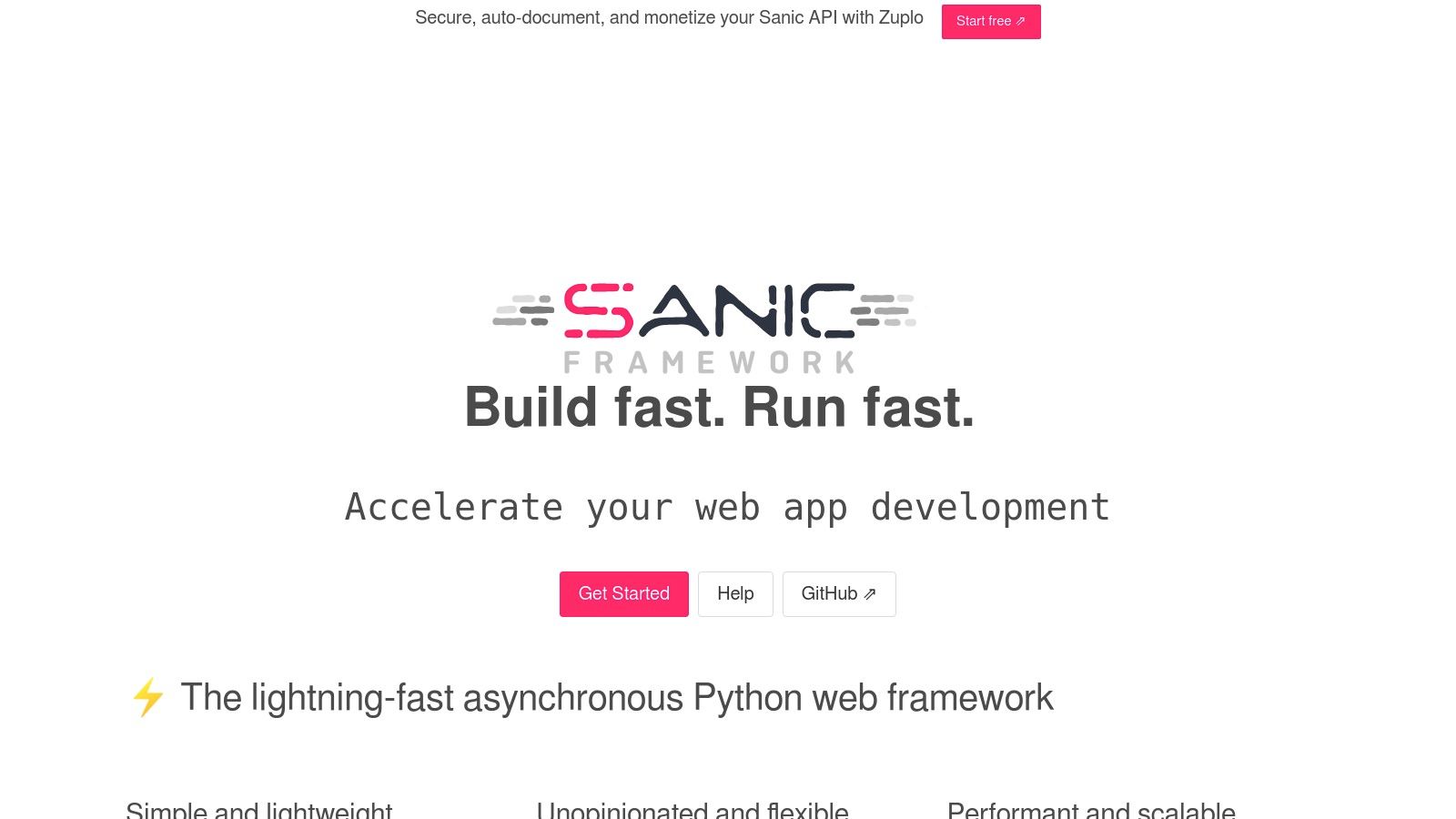
The platform's strength is its direct and focused approach. The docs get straight to the point, explaining core concepts like its ASGI compliance, routing, and middleware. While its ecosystem is smaller than that of Flask or Django, this focus makes Sanic one of the best python frameworks for web development when building microservices or real time applications that depend on non blocking I/O. Its learning curve is gentle for those familiar with Python's async/await syntax, enabling rapid development of extremely performant APIs.
- Best For: High performance APIs, microservices, and real time applications leveraging async I/O.
- Pros: Extremely fast and built for concurrency, clear and concise documentation, and active community channels.
- Cons: Smaller ecosystem compared with Django and Flask, less turnkey for building full stack HTML sites.
- Website: https://sanic.dev/
8. Bottle (official docs)
For those moments when a full scale framework is like using a sledgehammer to crack a nut, the Bottle official documentation is the go to resource. It introduces a microframework that is distributed as a single file with zero external dependencies. The website itself mirrors the framework's philosophy: it is a lean, no nonsense hub for a tool that prioritizes speed and simplicity above all else.
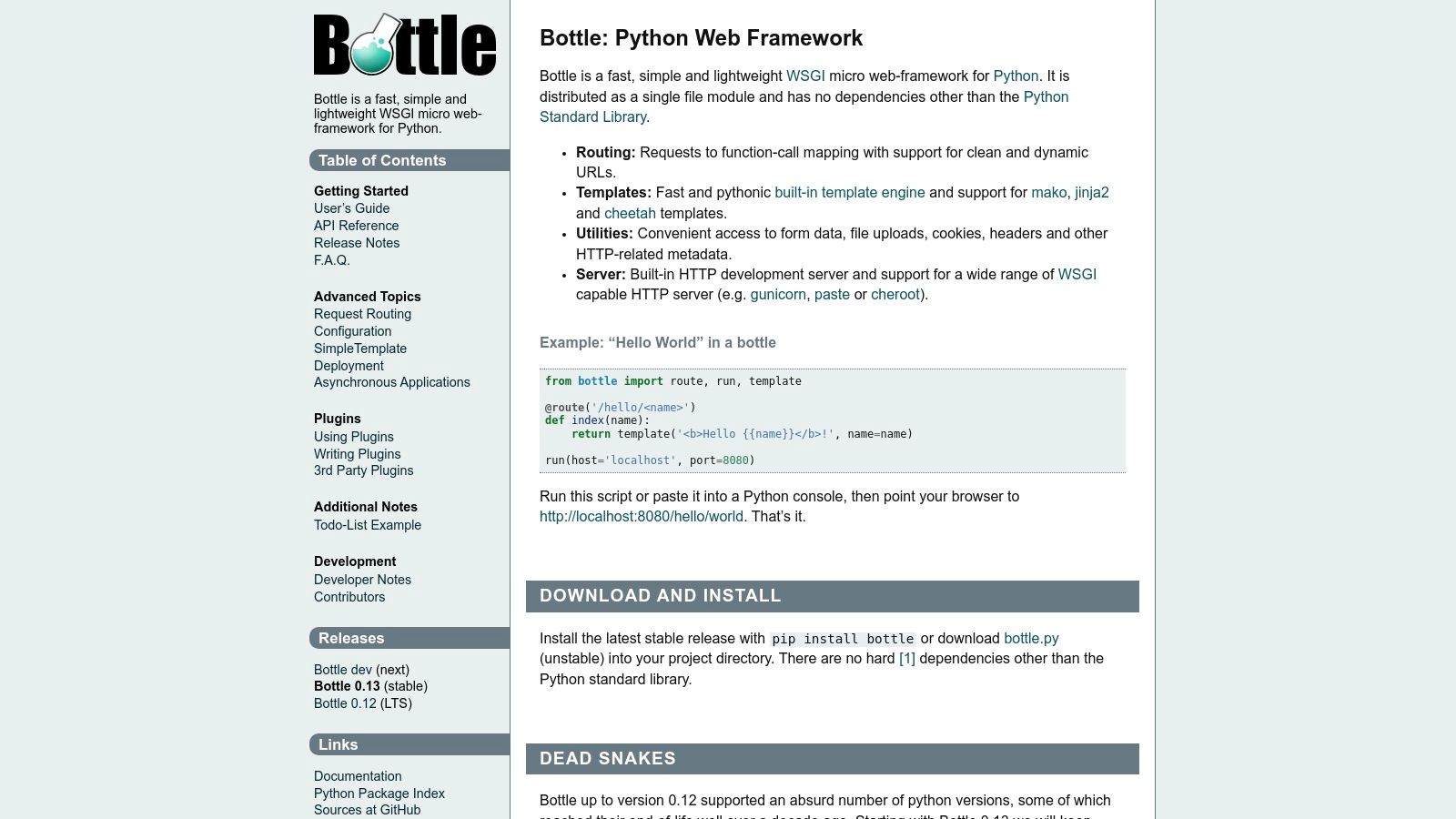
The platform's primary strength is its directness. The documentation is clear, concise, and gets developers running in minutes. While Bottle is intentionally not designed for large, complex applications, its single file nature makes it perfect for quickly prototyping an API, building small web utilities, or embedding a web interface into an existing application. For developers needing to get a simple idea off the ground with virtually no setup, Bottle provides an elegant and effective solution.
- Best For: Small scale APIs, prototypes, embedded web applications, and learning web framework concepts.
- Pros: Extremely lightweight (single file), zero dependencies, very low learning curve, and easy to embed.
- Cons: Not suitable for large or complex projects, and has a much smaller plugin ecosystem than larger frameworks.
- Website: https://bottlepy.org/docs/stable/
9. Falcon (official)
When your primary goal is building blazing fast, reliable REST APIs and microservices, the official Falcon website is where you turn. It's the home for a minimalist, high performance Python framework designed for speed and correctness, making it a contender among the best python frameworks for web development for API centric backends. The site is a lean, focused resource, providing clear documentation and core philosophy without unnecessary fluff.
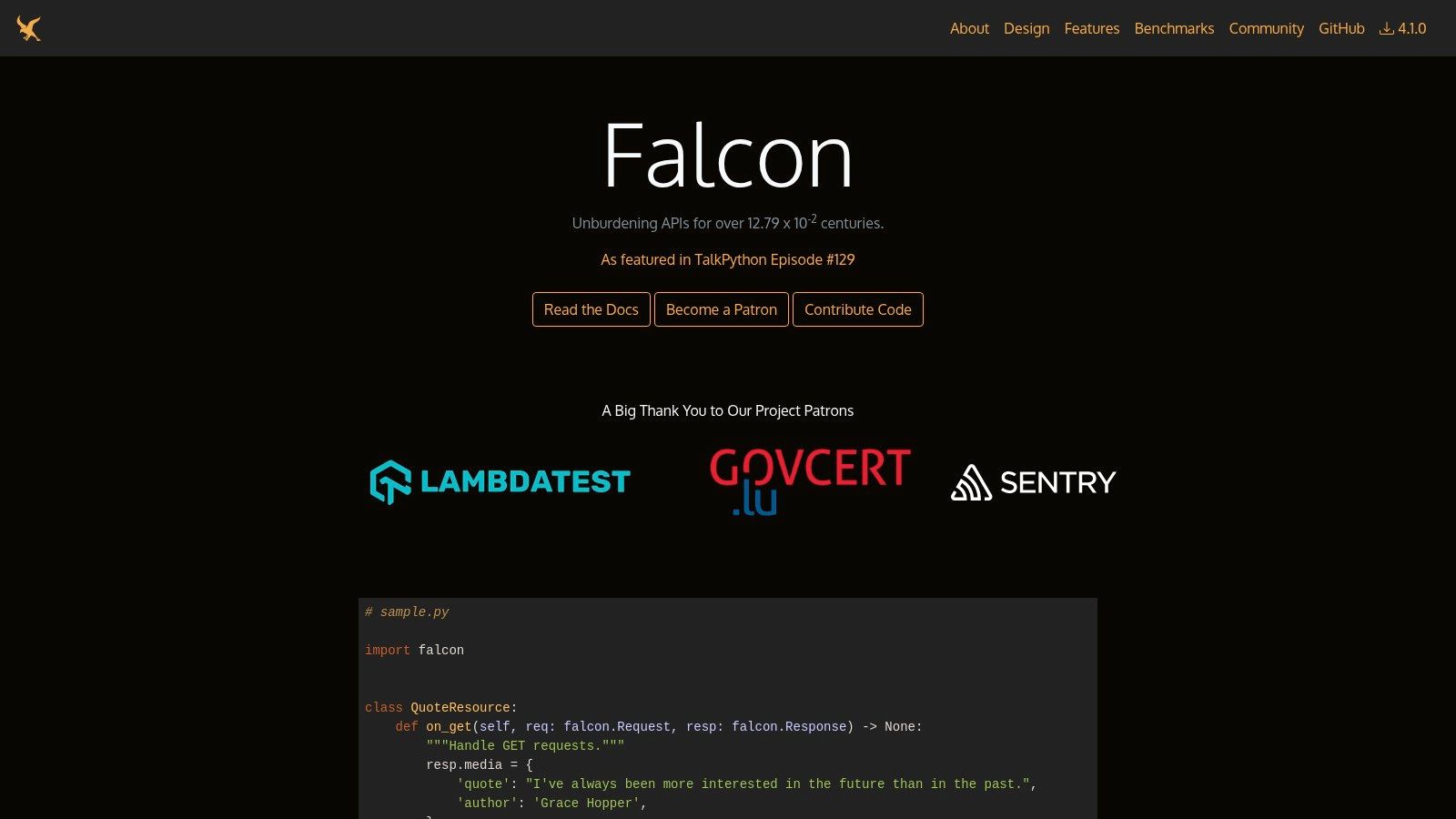
The platform's main strength lies in its direct and well organized documentation that reflects the framework's design: minimal abstractions and a focus on standard protocols. Developers appreciate its tiny attack surface and zero hard dependencies, which grant full control over the application stack. While Falcon intentionally omits features like an ORM, this "bring your own" approach is perfect for seasoned developers building mission critical systems. Its native support for both ASGI and WSGI ensures compatibility with modern servers like Uvicorn and Gunicorn.
- Best For: High performance REST APIs, microservices, and backend systems where speed and reliability are critical.
- Pros: Excellent performance with a small, focused core, highly dependable, and offers great flexibility for custom stacks.
- Cons: Provides few batteries, requiring you to choose your own ORM/auth solutions; has a smaller community than Django or Flask.
- Website: https://falconframework.org/
10. PyPI — The Python Package Index (official)
Before we go deeper, here's a crucial checkpoint. While not a framework itself, the Python Package Index (PyPI) is the indispensable starting point for accessing nearly every tool on this list. It is the official third party software repository for Python. For anyone searching for the best python frameworks for web development, PyPI is where you go to get the actual software, check release histories, and compare dependencies.
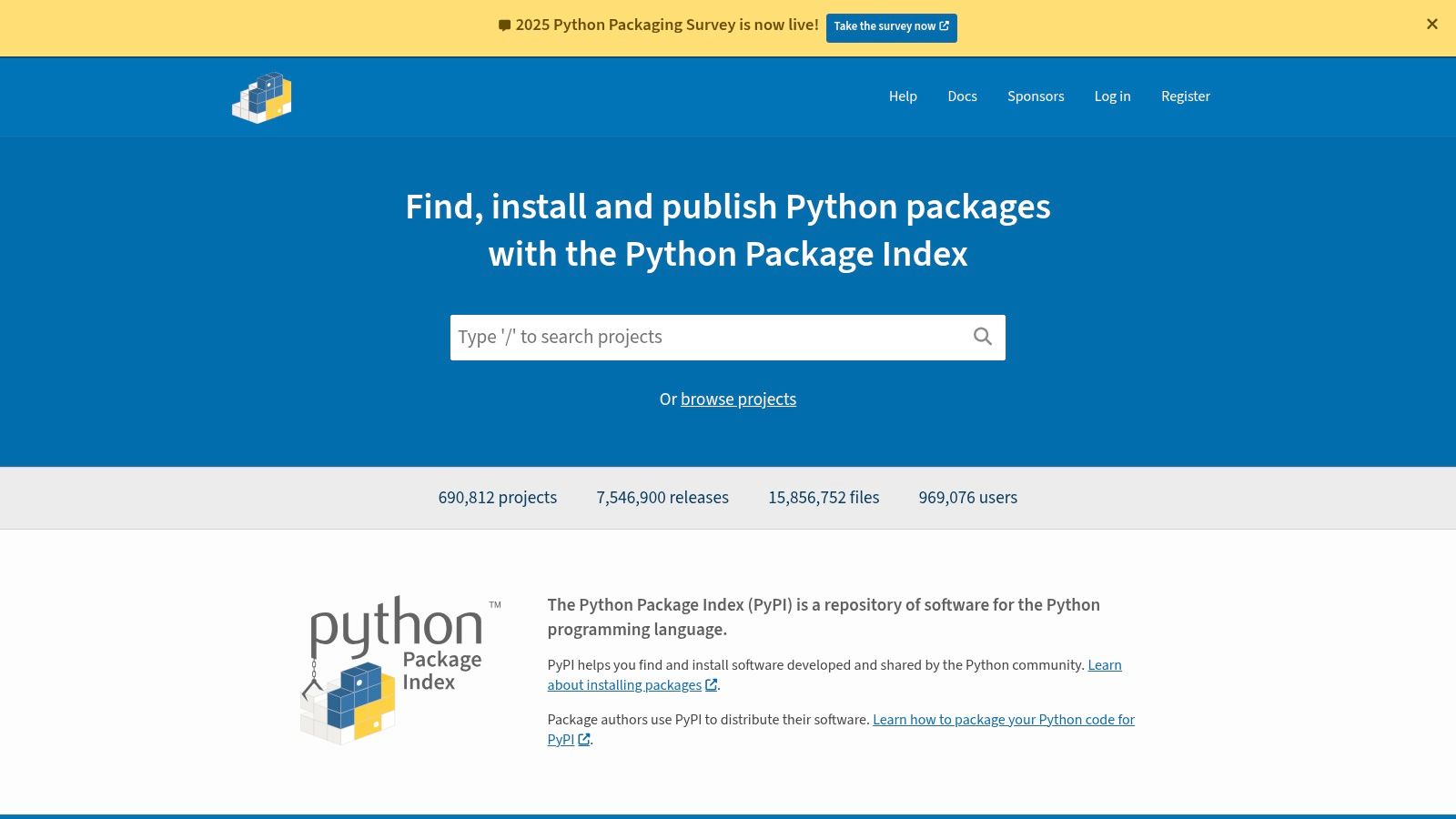
The platform's core strength lies in its role as a centralized, searchable index integrated directly with pip, Python's package installer. You can instantly access different versions of frameworks like Django or Flask, examine their metadata, and view project maintainer information. This makes it an essential resource for due diligence, allowing you to verify a package's activity and community support before committing to it. It is less a learning resource and more a critical piece of infrastructure.
- Best For: Accessing and installing all Python web frameworks and libraries, verifying package versions, and managing dependencies.
- Pros: The canonical source for all Python packages, direct integration with pip for easy installation, and detailed release history.
- Cons: Purely a repository, not a tutorial site; users must be cautious of typosquatting and verify package authenticity.
- Website: https://pypi.org/
11. Coursera — Django Web Framework (Meta)
For aspiring developers who prefer a structured learning path over self guided exploration, this Coursera specialization from Meta is an excellent entry point. It's not a framework itself but a comprehensive educational resource designed to take you from a beginner to a competent Django developer. The platform offers a guided curriculum with video lectures and hands on labs, making it ideal for those who thrive with clear goals and feedback.
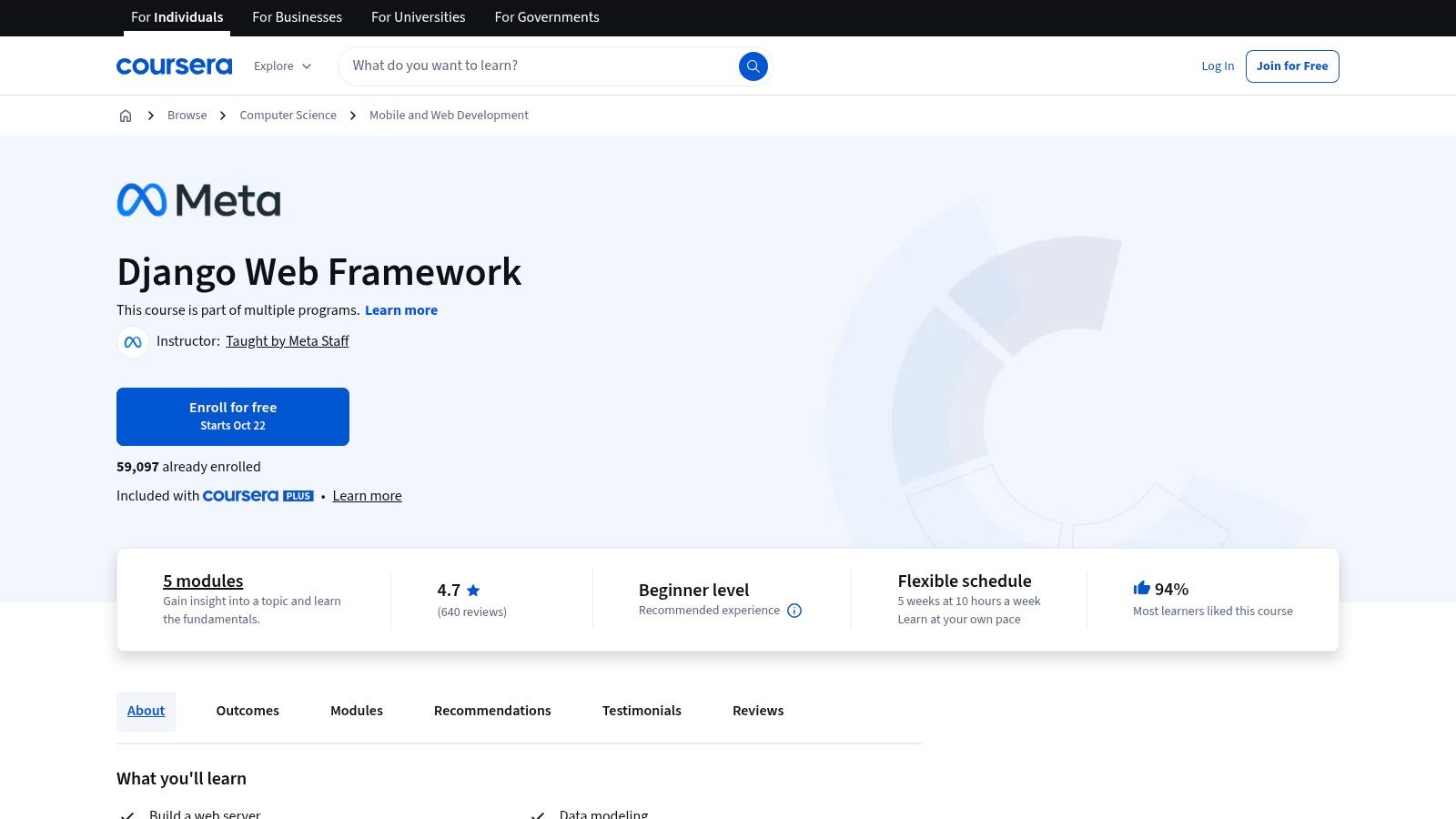
The course's strength lies in its syllabus, which covers core Django concepts like models, views, and templates in a logical progression. The hands on projects ensure you're not just passively watching videos but actively building and problem solving. While it requires a Coursera subscription for full access, the reputation of the platform provides a level of quality assurance. It stands out by transforming the complex Django ecosystem into a digestible, step by step journey, complete with a professional certificate to validate your newfound skills.
- Best For: Beginners seeking a structured, instructor led introduction to the Django framework.
- Pros: Reputable platform with a clear syllabus, guided learning path, and an optional professional certificate.
- Cons: Requires a subscription for full access, and focuses solely on Django rather than comparing frameworks.
- Website: https://www.coursera.org/learn/django-web-framework
12. AWS Marketplace — TurnKey Django AMI
For development teams that need to get a production ready Django environment running on Amazon Web Services without the manual setup, the TurnKey Django AMI on AWS Marketplace is an accelerator. Instead of configuring an operating system and web server from scratch, this offering provides a prebuilt Amazon Machine Image. It's designed to streamline deployment, allowing you to launch a complete, secure Django stack on an EC2 instance in minutes.
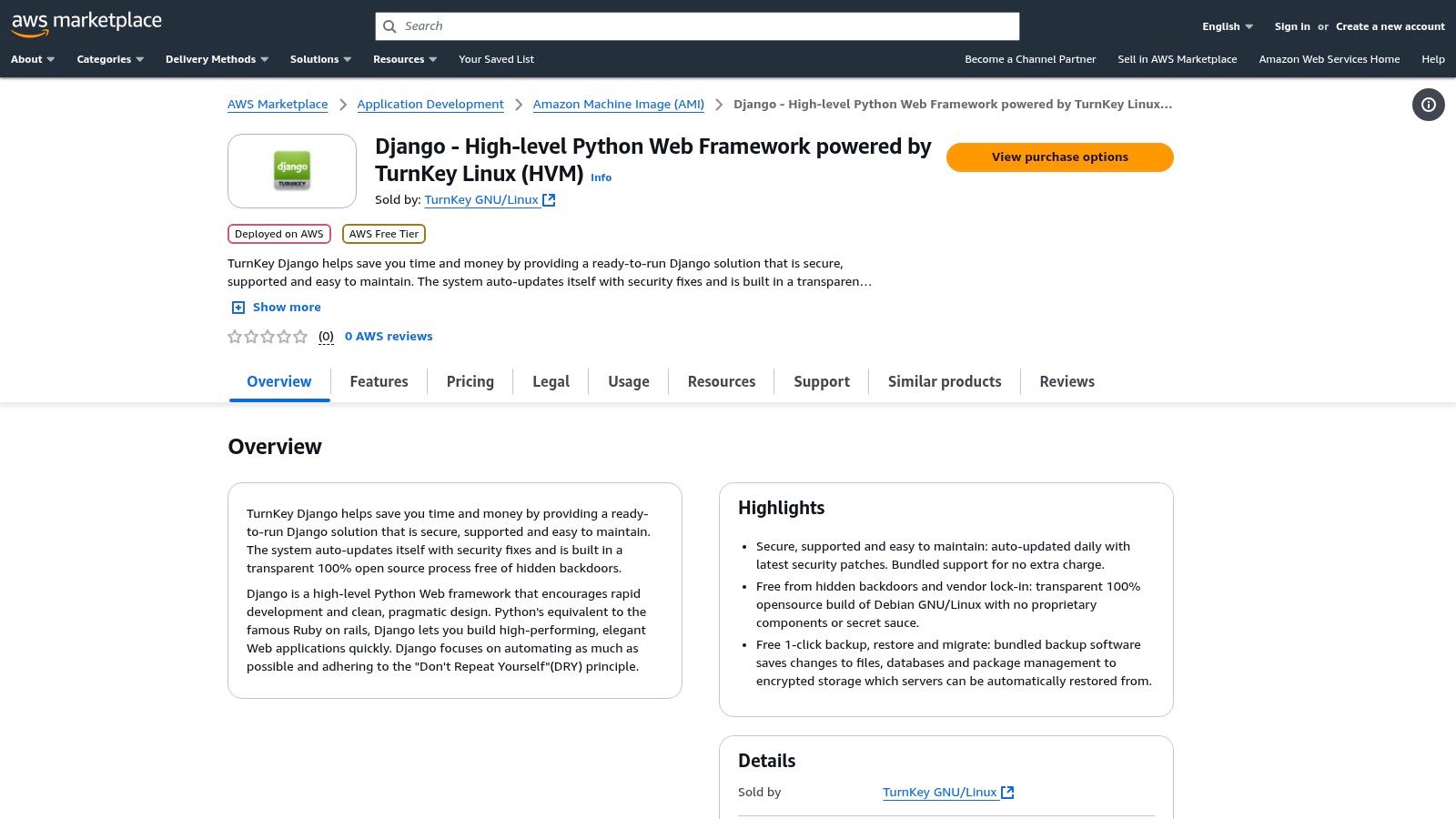
The platform's value lies in its convenience, packaging a Debian or Ubuntu based system with Nginx, PostgreSQL, and Django preconfigured for security and performance. While this is great for rapid prototyping or for teams without deep DevOps expertise, it abstracts away the underlying configuration details. For those interested in understanding the broader context of where specialized solutions like TurnKey Django AMIs are offered, you can explore this AWS Marketplace overview. This tool is less a framework itself and more a powerful deployment vehicle for one.
- Best For: Rapid prototyping, production evaluation on AWS, and teams wanting to minimize infrastructure setup time.
- Pros: Drastically reduces server setup time, provides a secure and optimized stack out of the box, and simplifies deployment on AWS.
- Cons: Billed via AWS for EC2 and any vendor fees; less educational for those wanting to learn infrastructure configuration from the ground up.
- Website: https://aws.amazon.com/marketplace/pp/prodview-tskptagzoreta
Top 12 Python Web Frameworks & Resources Comparison
| Item | Core features | Best for / Target audience | Unique selling points | Trade offs / Considerations |
|---|---|---|---|---|
| Django (official) | Batteries included: ORM, admin, auth, forms, migrations | Large DB driven sites, startups needing rapid CRUD/admin & long term maintainability | Mature ecosystem, strong security & LTS, excellent docs | Opinionated/heavier for small APIs; steeper learning curve |
| Flask (official docs by Pallets) | Minimal core (Jinja, Werkzeug), pluggable extensions | Small to medium apps, prototypes, teams wanting flexibility | Lightweight, large extension ecosystem, easy to start | Must assemble ORM/auth/admin; fewer batteries included |
| FastAPI (official) | Type hint first, async, auto OpenAPI docs, Pydantic validation | High performance async APIs, developer centric microservices | Excellent dev DX, type safety, top async performance | Geared to APIs (not server side HTML); relies on external full stack pieces |
| Pyramid (official) | Small core, choose templating/DB, explicit component choices | Teams wanting fine control; projects scaling from small to large | Balanced control vs simplicity; predictable behavior | Smaller community; fewer starter kits and integrations |
| Tornado (official docs) | Non blocking I/O, built in WebSockets, async primitives | Real time apps, long lived connections, high concurrency | Battle tested for persistent connections and WebSockets | Lower level; more manual plumbing; smaller ecosystem |
| Starlette (official) | ASGI toolkit: WebSockets, background tasks, middleware | High performance async microservices and APIs | Minimal, very fast, modular foundation (powers FastAPI) | Not full stack — ORM/admin/templates are optional add ons |
| Sanic (official docs) | Async first routing, middleware, CLI; ASGI compatible | High throughput services focused on concurrency and speed | Performance oriented, clear docs, active channels | Smaller ecosystem; less turnkey for full stack HTML apps |
| Bottle (official docs) | Single file WSGI microframework, built in templating | Tiny apps, prototypes, embedded use, demos | Extremely small footprint, zero external deps | Not intended for complex/large projects; few plugins |
| Falcon (official) | Minimal abstractions, RFC compliant HTTP, ASGI/WSGI | Mission critical REST APIs and microservices | Small attack surface, reliability and speed for REST | Few batteries — you choose ORM/auth; smaller community |
| PyPI — The Python Package Index (official) | Searchable package index, release files, metadata, pip install | Developers seeking packages, release history, artifacts | Canonical source for package distributions and metadata | Not a learning site; verify projects (typosquatting risk) |
| Coursera — Django Web Framework (Meta) | Structured course, labs, assessments, certificate option | Learners who want guided, assessed Django training | Hands on labs, graded assignments, certificate path | Subscription or paid certificate; Django focused only |
| AWS Marketplace — TurnKey Django AMI | Prebuilt Debian/Ubuntu AMI with Django stack, backups | Teams wanting fast EC2 deployment or eval instances | Ready to run image reduces infra setup time | AWS billing + possible vendor fees; less hands on learning |
Making Your Choice and Moving Forward
We have navigated a landscape filled with powerful tools, each a different answer to the question of how to build for the web with Python. We've seen Django, the batteries included behemoth. We explored the minimalist elegance of Flask and Bottle, canvases waiting for an artist. Then we dove into the asynchronous world with FastAPI, Sanic, and Starlette, frameworks built for the modern era of high concurrency and lightning fast APIs.
The journey through these options can feel overwhelming. I have been at this exact junction with multiple early stage startups, weighing the immediate need for a product against the long term vision of a scalable architecture. The key lesson learned is that the choice is less about a universally "best" framework and more about a contextually "right" one. Your decision is a reflection of your project's soul.
Key Takeaways for Your Decision
So, how do you make the final call? Let's distill the process down to a few critical questions you should ask yourself and your team:
- What is the project's scale and complexity? For a large platform like an e commerce site, Django's integrated components provide a massive head start. For a single purpose microservice, FastAPI or Flask is often a more direct route.
- What is your team's expertise? If your team is full of Django veterans, switching to an asynchronous framework like Sanic might introduce a steep learning curve. The best python frameworks for web development for your team are the ones that leverage existing knowledge.
- What are your performance requirements? If you are building a real time chat application or a high traffic API, the asynchronous capabilities of FastAPI, Starlette, or Tornado are essential.
- How much control do you need? Do you prefer a framework that makes decisions for you (like Django)? Or do you want to piece together your stack with best in class libraries, maintaining granular control (like with Flask or Pyramid)?
Ultimately, this is not a one time decision but the start of a long term relationship with a technology stack. The "best" choice is the one that empowers your team to build, iterate, and solve user problems effectively, not just today but a year from now.
Navigating these architectural decisions can be one of the most critical challenges for a startup. If you're a founder or CTO trying to select the right foundation for your product, from a simple API to a complex AI driven platform, I can help. At Kuldeep Pisda, I provide on demand technical mentorship and CTO as a service to help you make these crucial choices with confidence. Let's build something scalable together. Kuldeep Pisda
Become a subscriber receive the latest updates in your inbox.
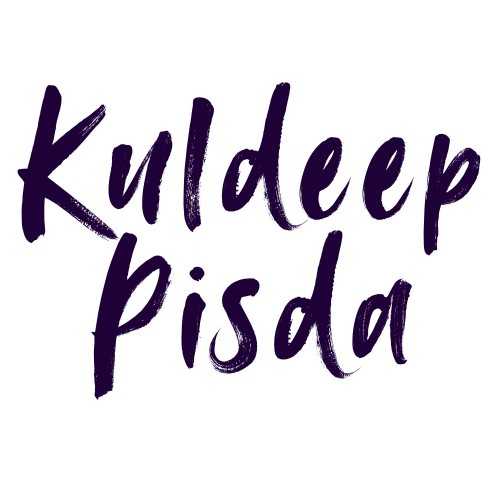

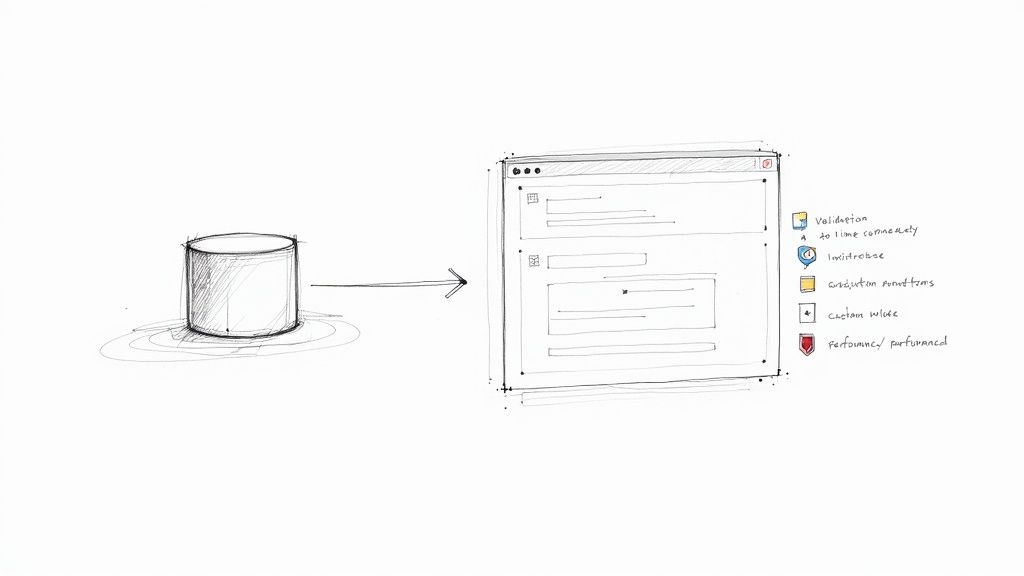
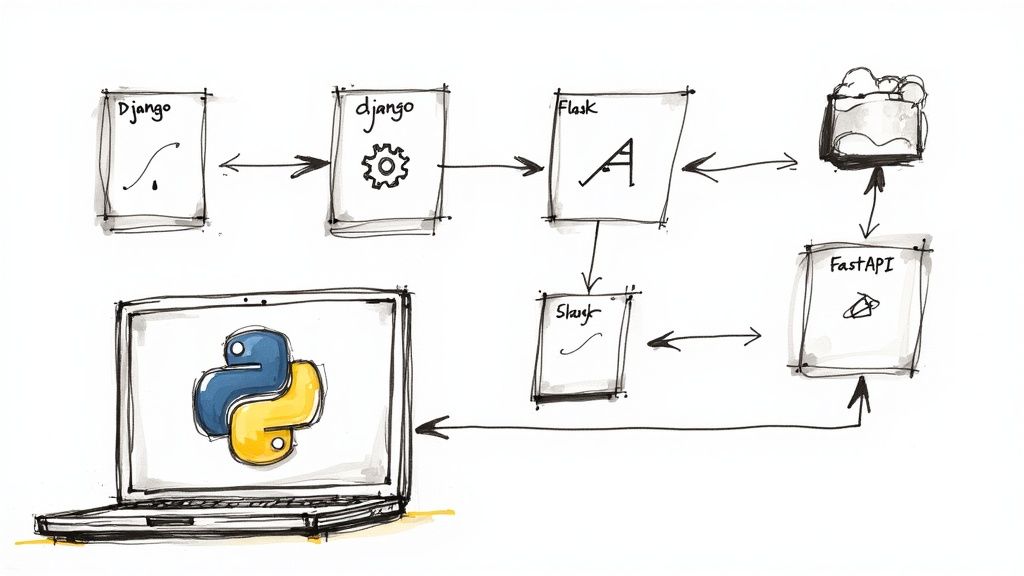
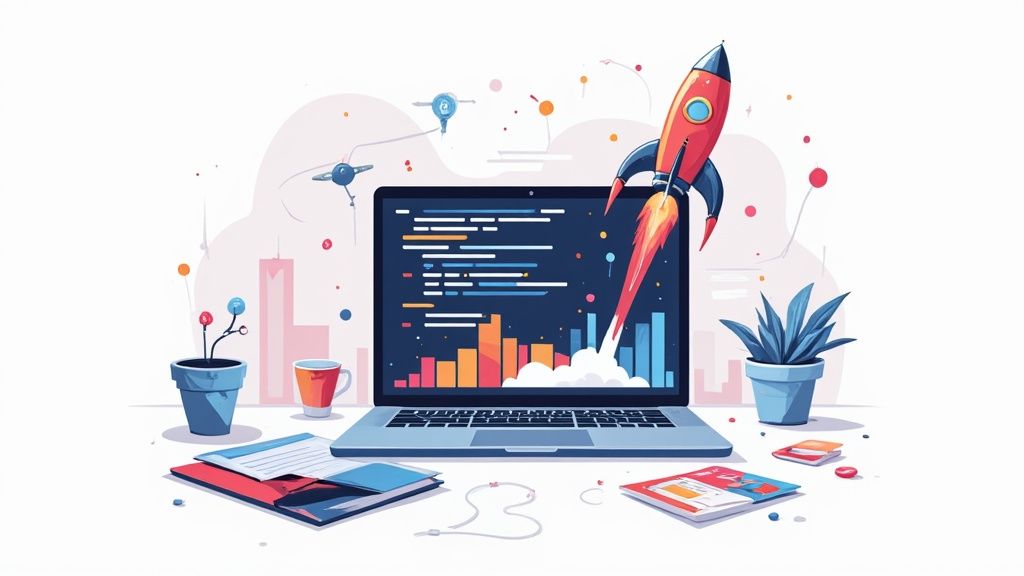

Member discussion